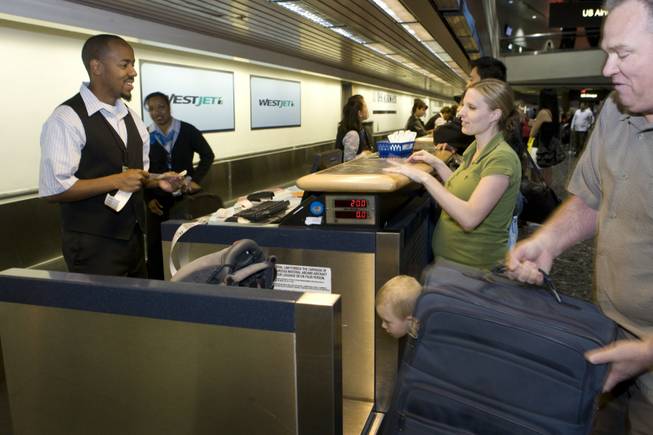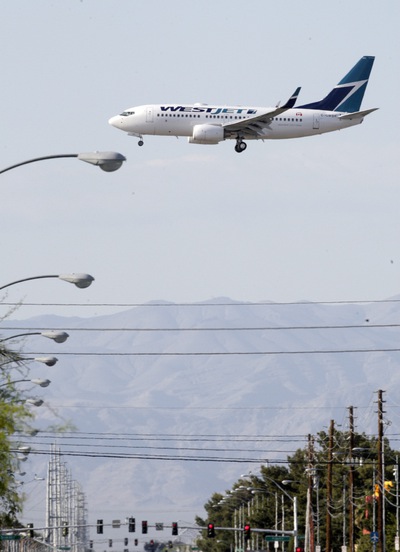
WestJet agent Demetri Humphrey checks in baggage for Sarah Bonnett and her son, Braxton, 2, at McCarran International Airport as Bonnett’s father, Danny Sanders, helps with the luggage.
Friday, April 30, 2010 | 3 a.m.
Nothing says “international travel” like the sight of a Virgin Atlantic Airways’ Boeing 747 jumbo jet from London floating in over the Strip every day.
The big airliners from Virgin, British Airways, Korean Airlines and Philippine Airlines get most of the attention for international flights to McCarran International Airport.
But the foreign air carrier that delivers the most international passengers to Las Vegas isn’t a household name, nor does it fly jets that attract much attention.
It’s WestJet Airlines, and over the past four years it has quietly been McCarran’s biggest growth story.
Based in Calgary, Alberta, WestJet flies its Boeing 737 twin-engine jets 74 times a week between McCarran and 10 Canadian cities.
With more than 150,000 passengers flying WestJet to Las Vegas in the first two months of 2010 — the ninth busiest commercial flier at the airport — the airline is on track to deliver more than 700,000 people this year, easily the biggest deliverer of international visitors to Southern Nevada.
By comparison, Canadian rival Air Canada had 73,396 passengers in the first two months of 2010, and Mexico’s dominant carrier, Mexicana, had 32,592. Virgin Atlantic flew 32,922 passengers from London in the same time, and market newcomer British Airways flew 27,729.
“It’s a good story,” Clark County Aviation Director Randall Walker said. “They’ve had phenomenal growth here. They had 200,000 passengers here their first full year of operations, and we’re expecting about 730,000 people this year. Overall, passenger traffic has been down for us this year, but WestJet’s is up around 17 percent. Their loads have been running around 87 percent full out of here.”
Optimism has been running high that WestJet, with a fleet of 88 planes, would continue to feed more traffic to Las Vegas because it had signed a code-share agreement with Dallas-based Southwest Airlines, the market leader in Las Vegas. Under the deal, customers would buy tickets from either airline and there would be a seamless transfer of passengers and bags at an airport serving both airlines.
McCarran was a likely transfer point, particularly on flights in the western United States and western Canada.
McCarran prepared for that eventuality by working with WestJet to make the flow of passengers easier, bringing several WestJet flights into McCarran’s B gates, which are accessible to Southwest flights in the C gates via a new pedestrian bridge.
But the code-share deal fell apart.
WestJet announced early this month that it was working on a new code-share deal with Delta Air Lines involving flights at New York’s LaGuardia Airport. Southwest officials first heard about that in the media and were particularly stunned because they have been trying to get additional gate space and takeoff and landing slots at LaGuardia since the airline began service there last year.
The proposed Delta deal didn’t sound like anything Southwest wanted to hear and last week, Southwest announced it was withdrawing its code-share deal with WestJet. Neither airline has commented publicly about the deal falling apart or the specific reasons for the split.
Although a Southwest-WestJet code-share wouldn’t directly benefit Las Vegas since McCarran would be a transfer point for Southwest customers going to Canada and WestJet customers coming to the United States, most agreed that there would be greater tendency for both airlines to add flights to make the code-share more effective.
Even Walker has changed his tune about McCarran as a transfer point.
Walker used to say that he preferred “origination and destination” passengers — those getting off the planes in Las Vegas instead of transferring — because they would stay at the resorts and spend money in the city. But after seeing carriers such as US Airways removing capacity from the market, Walker now thinks “every passenger is our favorite kind of passenger.”
Even without the code-share, WestJet is poised for growth.
Walker said the airline “is sniffing around about a new gate.” He said McCarran is prepared to handle more WestJet customers, but he acknowledged that “I usually find about new flights about an hour before the press release comes out.”
WestJet flights into Las Vegas have some unique qualities. Most international flights arrive at Terminal 2, the location of U.S. Customs and Immigration officers who clear arrivals from foreign countries.
But Canada has developed a system of clearing passengers before they leave from that country’s largest airports. Flights from big cities such as Toronto, Montreal and Calgary are pre-cleared and go straight into McCarran’s Terminal 1.
Smaller Canadian cities that don’t have pre-clearing systems, such as Kelowna, British Columbia, and Regina, Saskatchewan, still have to arrive at Terminal 2.
All WestJet departures go out of Terminal 1’s B gates.
Bob Cummings, WestJet executive vice president of marketing and sales, said Las Vegas and WestJet were made for each other because WestJet is all about making money and having fun doing it.
“We’re one of the world’s leading low-cost carriers by several different measures, profitability, brand reputation and employee culture,” Cummings said.
WestJet was founded in 1996 by a group of Calgary business leaders headed by Clive Beddoe, a British pilot who decided on a whim to move to Canada and get into real estate but ended up instead teaming with three partners to get into aviation. The airline started by flying three aircraft among five cities.
The company grew domestically and in 2004 began its first trans-border service with flights between Canada and Los Angeles, San Francisco, Phoenix, New York City’s LaGuardia Airport and Fort Lauderdale, Tampa and Orlando, Fla.
That year, the company enjoyed its third stock split and it continued to grow its domestic and international routes. In June 2006, the company launched its WestJet Vacations product packaging airfares with hotel stays in 14 tourist markets.
In 2007 and 2008, WestJet was the fourth most profitable airline in the world and the nonunion company with 7,600 employees is on a run of 19 consecutive profitable quarters, Cummings said.
The company has been recognized by Waterstone Human Capital as Canada’s leader in corporate culture for the last five years and the airline is well known for being a fun place to work.
WestJet officials enjoy being a part of April Fools’ Day pranks. A few years ago, the company announced that it was offering overhead luggage bins as sleep units and this year, a news release said the company had perfected clapper technology so that passengers could turn lights on and off and change channels on their television systems by clapping their hands.
The announcements got big laughs and lots of publicity, but customers who read through the news releases that were part of the pranks were directed to a website that offered discounted fares on flights purchased that day.
WestJet shares many similarities with two popular discount carriers based in the United States, Southwest and JetBlue.
The company has opted to use one aircraft type — the Boeing 737, like Southwest. The airline currently operates the 600, 700 and 800 series versions of the plane.
Unlike Southwest but like JetBlue, WestJet offers in-seat live television entertainment systems for passengers. Like Southwest, WestJet allows passengers to check two suitcases without charge.
Most of the airline’s customers, called “WestJetters,” are Canadians seeking to escape their harsh winters. As a result, WestJet offers lots of warm-weather leisure destinations: Mexico, Hawaii, the Caribbean and Cuba.
“It’s tough to make money in Canada because there are so few population centers,” said Mike Boyd, an aviation consultant and analyst with Evergreen, Colo.-based Boyd International.
“It’s gray and cold for much of the year and the people like to go to places to see if the sun still exists,” Boyd said. “They’re pretty tapped out in Canada, so the trans-border flights, Hawaii, the Caribbean and certainly Las Vegas make a lot of sense for them.”



Join the Discussion:
Check this out for a full explanation of our conversion to the LiveFyre commenting system and instructions on how to sign up for an account.
Full comments policy